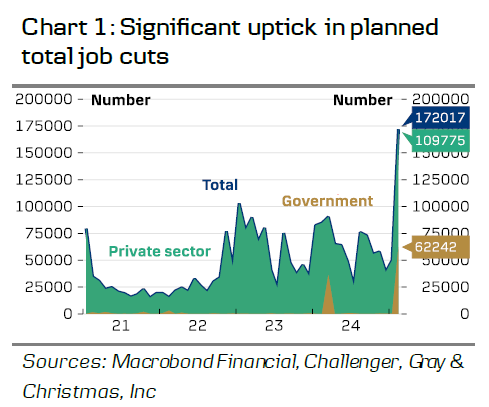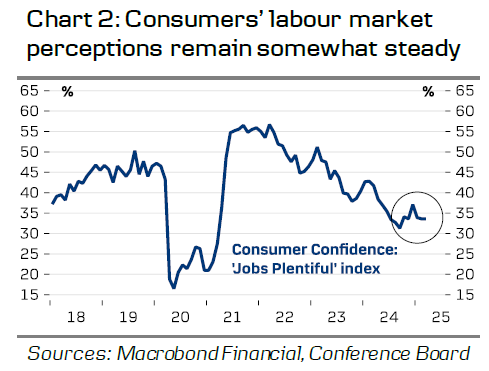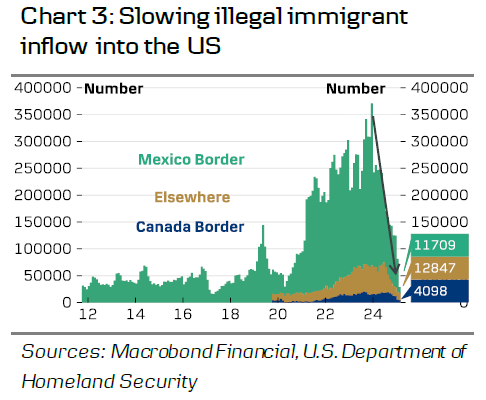We expect early April labour market data to continue signalling cooling, but still steady growth. Federal layoffs and sharply cooling immigration are set to weigh on employment growth over coming months, but the low number of jobless claims on the private sector suggests overall conditions remain stable.
We think that this week's March Jobs Report will show nonfarm payrolls (NFP) growth slowing to just 110k. Unemployment rate will likely tick higher to 4.2% but we do not expect to see a much further increase in the near-term given the tightening labour supply.
Last month's report was a mixed bag, as NFP growth remained at 151k despite the apparent headwinds. The participation rate edged down to 62.4% from 62.6%, but decomposing the figure reveals that the downtick attributed to an outflow of workers in the categories "55 years & over" and "20 to 24 years", while the prime-age participation rate remained at 83.5%.
The January JOLTs report was also solid, with job openings ticking higher to 7.7m (cons: 7.6, prior: 7.5m), and involuntary layoffs continuing their downward trend for the fourth consecutive month, reaching 1.6m (prior: 1.7m). Coupling this with jobless claims and the WARN advance notifications for mass layoffs hovering at modest levels, labour market conditions appear to remain steady.
In light of the DOGE-related layoffs, the February jobs report pointed towards only a muted impact so far. This could, however, be due to the BLS survey reporting period ending before the settlement of the layoffs. Looking at the Challenger report for planned layoffs by US firms, the picture is quite different, with 172k announced job cuts in February (chart 1). Reductions on the public sector accounted for around 62k, but private sector numbers were up as well, perhaps due to cancelled government contracts and fear of trade wars. We recommend keeping an eye out for the upcoming March Challenger report, which could provide further clarity on the scale of DOGE's federal layoffs.
Consumer confidence continues to deteriorate, hitting the lowest level since 2013. Consumers have reported especially their future employment prospects weakening - potentially due to the uncertainty related to job cuts and higher inflation expectations. However, consumers' perception of current labour market conditions remains steady (chart 2), suggesting that the situation might not be as dire as what the headline shows.
While immigration has been the most important driver of labour supply growth in the past years, the situation has changed completely (chart 3). Immigration slowed at a record pace, with illegal border crossings declining to just 28k in February, lower than during peak COVID-restrictions. With native-born labour force growth set to structurally decline, labour supply alone is likely to become a drag on potential growth. Notably, the effect is already evident in labour market readings, as the flow of workers from outside the labour force and into employment has slowed steadily over the past year.
This publication has been prepared by Danske Bank for information purposes only. It is not an offer or solicitation of any offer to purchase or sell any financial instrument. Whilst reasonable care has been taken to ensure that its contents are not untrue or misleading, no representation is made as to its accuracy or completeness and no liability is accepted for any loss arising from reliance on it. Danske Bank, its affiliates or staff, may perform services for, solicit business from, hold long or short positions in, or otherwise be interested in the investments (including derivatives), of any issuer mentioned herein. Danske Bank's research analysts are not permitted to invest in securities under coverage in their research sector.
This publication is not intended for private customers in the UK or any person in the US. Danske Bank A/S is regulated by the FSA for the conduct of designated investment business in the UK and is a member of the London Stock Exchange.
Copyright () Danske Bank A/S. All rights reserved. This publication is protected by copyright and may not be reproduced in whole or in part without permission.
Recommended Content
Editors’ Picks

EUR/USD advances to multi-day highs around 1.0860
EUR/USD is surging ahead, rapidly recovering and approaching multi-day highs around 1.0860. This boost comes on the heels of news that the EU might roll out countermeasures to soften the blow of Trump’s impending reciprocal tariffs.

GBP/USD flirts with tops near 1.2970 ahead of Trump's tariffs
GBP/USD is accelerating, challenging weekly highs near 1.2970 as a renewed, sharp drop in the Greenback sets the stage for the US 'reciprocal tariffs' announcement on "Liberation Day" at 20:00 GMT.

Gold looks consolidative near $3,120 ahead of Trump's “Liberation Day”
Gold is regaining momentum, climbing above $3,120 after a slight pullback from Tuesday’s near-record high of $3,150. Retreating US yields are bolstering XAU/USD, ahead of President Trump's official announcement of the reciprocal tariff measures later this Wednesday.

Trump Tariffs: Everything you need to know on “Liberation Day” Premium
The global trading system is about to be upended, but to what extent? Will markets have clarity or is it merely another phase in ongoing trade wars? Some answers are due on Wednesday at 20:00 GMT. Here is preview of the five critical things to watch.

Is the US economy headed for a recession?
Leading economists say a recession is more likely than originally expected. With new tariffs set to be launched on April 2, investors and economists are growing more concerned about an economic slowdown or recession.

The Best brokers to trade EUR/USD
SPONSORED Discover the top brokers for trading EUR/USD in 2025. Our list features brokers with competitive spreads, fast execution, and powerful platforms. Whether you're a beginner or an expert, find the right partner to navigate the dynamic Forex market.


